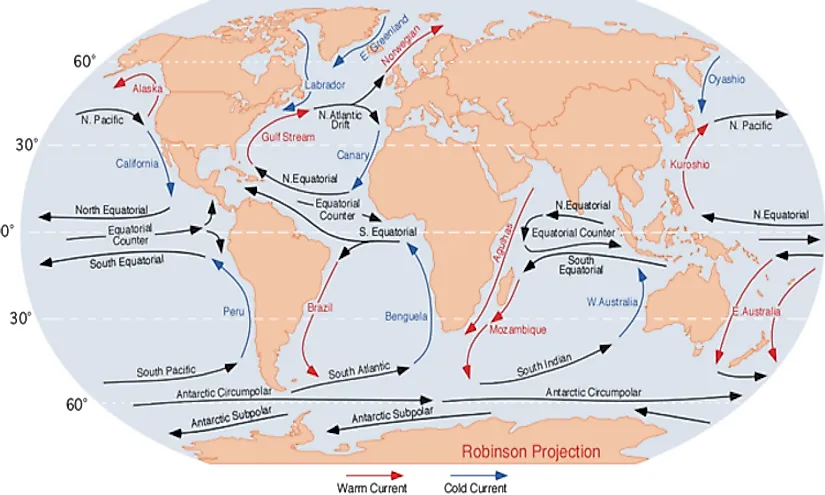How Do Ocean Currents Affect Climate?

Ocean current is a directed permanent or continuous movement of ocean’s water. The movement of the ocean water is caused by forces acting on the water including the breaking waves, salinity differences, Coriolis effects, the wind, temperatures, and cabbeling. The current direction is influenced by the shoreline, other currents, and the depth of the contours. The ocean currents can flow for thousands of kilometers and create a global conveyer belt which is important in determining the climate of different regions of the earth. Ocean currents are either on the surface of the ocean or in the deep waters below 300 meters. The currents can also move either horizontally or vertically depending on the cause. The ocean currents can also be influenced by the shape of the ocean basin, topography, and the land masses bordering the Ocean.
Warm And Cold Currents
Cold ocean currents are masses of cold water moving from high latitude towards the equator absorbing the heat received in the tropics thus cooling the air above. Cold currents are formed when the air circulating the eastern side of the subtropical high is blown over cold water mass and are then dragged toward the equator. Warm currents are masses of warm water with higher temperatures moving away from the equator. Warm currents are formed when the cold saline water becomes dense and sinks allowing the light warm water to flow in the opposite direction, usually far from the equator.
How Do Ocean Currents Affect Climate?
Horizontal currents moving northward or southward may carry warmed or cooled water for very long distance. The displaced warm water raises the temperature of the air while the cold water cools the air, and the land surface where the blows. For instance, water from the tropical Atlantic moves northwards through Atlantic in a Gulf Stream suffusing the Western Europe’s shores thus producing a mild climate. The mild climate raises the temperatures of the region higher than the regions across the Atlantic but on the same latitude. The Gulf Stream explains why Canada's east coast is locked in ice while England is not especially during winter. The current cooling events being experienced in Western Europe is attributed to the Gulf Stream slowing down as a result of the global warming which has caused the polar ice cap to melt and slowing down the Great Ocean Conveyor Belt.
Deep Water Formation Current
The surface cooling during winter makes the surrounding water become denser. After the surface water has become thicker than the underlying water, a process called convective overturning takes place where the dense water mixing downwards extending to the bottom. The dense mixed water spreads out at the bottom of the ocean. When this mixing takes place in higher latitude, a circulation pattern is created where warm water moves pole-wards from the tropics thus surrendering heat to the atmosphere resulting in the transportation of heat pole-wards. The cycle repeats itself over and over influencing the transfer of heat from the equator to the highlands.
Ocean Current Movement
The current flow influenced by salinity, wind, topography and earth’s rotation brings cold water from the depths to the surface by pushing away the surface water. This process explains why the ocean is colder on the east coast than the west coast. The colder water sinks and moves towards Indian, Pacific, and Atlantic basin. The changes in current movements affect the coastal climate by carrying a lot of heat.
Ocean current is a directed permanent or continuous movement of ocean’s water. The movement of the ocean water is caused by forces acting on the water including the breaking waves, salinity differences, Coriolis effects, the wind, temperatures, and cabbeling. The current direction is influenced by the shoreline, other currents, and the depth of the contours. The ocean currents can flow for thousands of kilometers and create a global conveyer belt which is important in determining the climate of different regions of the earth. Ocean currents are either on the surface of the ocean or in the deep waters below 300 meters. The currents can also move either horizontally or vertically depending on the cause. The ocean currents can also be influenced by the shape of the ocean basin, topography, and the land masses bordering the Ocean.
Warm And Cold Currents
Cold ocean currents are masses of cold water moving from high latitude towards the equator absorbing the heat received in the tropics thus cooling the air above. Cold currents are formed when the air circulating the eastern side of the subtropical high is blown over cold water mass and are then dragged toward the equator. Warm currents are masses of warm water with higher temperatures moving away from the equator. Warm currents are formed when the cold saline water becomes dense and sinks allowing the light warm water to flow in the opposite direction, usually far from the equator.











